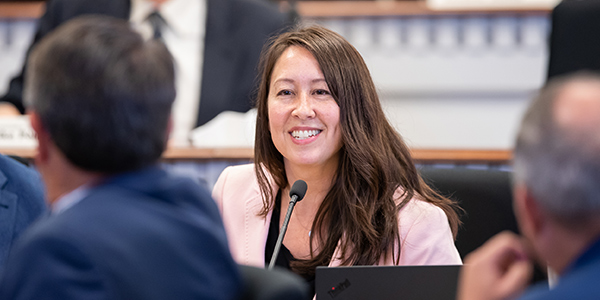A bill to require consideration of climate change in land use planning appears headed toward approval in the Washington state legislature (HB 1099).
On Monday, the Washington Senate’s Ways and Means Committee sent the bill to the floor by a 13-11 vote along party lines. Introduced by Rep. Davina Duerr (D), the bill passed in the House of Representatives along party lines on March 5. With Democrats controlling the Senate, Republicans are unlikely to drum up enough votes to kill the bill.
“Washington is the last state on the West Coast that doesn’t have climate change integrated in its growth management framework,” said Dave Anderson, Growth Management Act manager for the Washington Department of Commerce at a March 16 hearing before the House Housing and Local Government Committee.
Washington’s Growth Management Act, which is almost 30 years old, regulates long-range land use planning for Washington’s city and county governments. It requires counties and cities to review and, if needed, revise their comprehensive plans and development regulations every eight years.
Duerr’s bill would add climate change as a factor in the GMA and require comprehensive plans, development regulations and regional plans to support state greenhouse gas emission targets and improve resiliency to climate impacts and natural hazards.
Duerr’s bill would require climate change to be considered in land-use and shoreline planning for the largest 10 of Washington’s 39 counties and in cities of 6,000 people or bigger. Washington’s 10 largest counties cover Puget Sound, Spokane, the Yakima River Valley and the Washington-side suburbs of Portland.
A legislative memo said 246 county and city governments would be affected, including 110 jurisdictions outside the 10 most populous counties.
The bill calls for the state Department of Commerce to set guidelines by 2025 on how those areas can reduce GHG emissions and vehicle miles traveled. Because 40 to 45% of Washington’s greenhouse gas emissions come from motor vehicles, traffic issues would become a major priority in those guidelines, Duerr said in an interview.
Under the bill, the Department of Ecology would require that Shoreline Master Programs address the impact of sea level rise and increased storm severity.
Like several other climate change bills being tackled this session, HB 1099 builds on a 2008 law that orders the state to reduce its carbon dioxide emissions to 90.5 million metric tons, the level in 1990, by 2020. The law set emission goals of 50 million metric tons by 2030, 27 million metric tons by 2040, and 5 million metric tons by 2050.
The state Department of Ecology says the state’s CO2 emissions peaked 20 years ago at more than 108 million metric tons, before falling for several years following the Great Recession to 91.2 million metric tons in 2012. Emissions grew to 95.7 million metric tons in 2017 and 99.57 million metric tons in 2018. The 2020 figure has not been calculated.
“If you don’t plan for it, you don’t meet those goals,” Duerr said.
When county and city governments update their land-use plans, the bill would require them to take measures to decrease traffic emissions, to take into account population densities, and to tackle environmental justice issues, such as ensuring pollution is not concentrated in poor areas or communities of color.
The land use element of comprehensive plans would be required to give special consideration to achieving environmental justice and avoid creating or worsening environmental health disparities. It also must also reduce risks from wildfires, which could include limiting development in wildland urban interface areas.
In response to earlier criticism by local governments against unfunded mandates, Duerr added language to her bill ensuring the requirements would not go into effect unless the legislature appropriates enough money to handle the extra planning requirements.
“I made a commitment to the local governments that it would be paid for,” she said.
Most of those who testified at the March 16 hearing — the majority from environmental organizations, plus some city governments — supported the bill. They echoed Duerr’s stance that transportation emissions and population density contribute to global warming and need to be addressed.
“This will improve everyone’s health, especially health for children,” said Ken Lans, representing the Washington chapter of Physicians for Social Responsibility.
Danielle Shaw of the Washington Environmental Council said, “It prioritizes the most vulnerable populations.”
Opposition came from business, construction and Realtor associations. They focused on the possibility of unfunded mandates. They also worried that climate change concerns would take priority over housing shortages.
“We see the Growth Management Act shifting toward environmental issues … leaving the housing crisis behind,” said Bill Clarke, representing the Washington Realtors Association.



